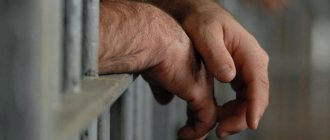Warning for a minor
One of the most loyal measures in cases where your minor child commits an act that is considered a criminal offense is to warn the minor.
Its essence lies in the fact that a law enforcement representative who works with minor teenagers conducts a preventive conversation. In his conversation, he explains in accessible language all the inevitable consequences that await any person who takes the criminal path. The use of this easiest of educational measures is possible when the crime is quite insignificant in its consequences and the teenager shows remorse for the crime committed.
After the conversation, it is advisable for the teenager to write a commitment in his own hand, in which it must be noted that he well understood the meaning of what he was warned about.
This document is signed by both the teenager and the person who conducted the warning conversation with him.
This leaves its mark and carries additional responsibility to the teenager in the fact that it is necessary to comply with the signed document.
Transfer of a minor to supervision
In addition to warning the teenager, in cases where a minor child from a fairly prosperous family has broken the law, it makes sense to place him under the supervision of his parents or people who actually raise him or who have replaced his father and mother. This can bring a positive effect only in cases where friendly, trusting relationships develop between adult family members and the teenager and the child listens to the opinions of the parents.
In order to make a decision to transfer a teenager who has committed a crime of minor or moderate gravity under the supervision of parents, the court must collect characteristics of the people who will be given the authority to control the teenager’s behavior.
When transferring the powers of supervision to parents or persons replacing them, all duties and rights assigned to them are explained, after which it is documented in writing against signature. As a matter of course, this implies the consent of the parents to take control over the teenager.
In cases where the lifestyle of adult family members of a teenager who has embarked on a slippery slope of crime gives reason to doubt that they can supervise a minor, this function is assigned to a government body specializing in these issues, for example, the criminal justice inspectorate. minors.
In such cases, the inspector regularly visits the so-called “difficult” teenager at home, at school, monitors his behavior and leisure activities, and conducts preventive conversations.
The period for which a court order or ruling can be made to take a teenager under supervision can range from two months to three years and up to his/her adulthood.
Commentary to Art. 90 Criminal Code
1. In Art. 90 of the Criminal Code contains a special type of release of a minor from criminal liability with the use of compulsory educational measures.
The basis for the application of this norm is the commission of a crime of minor or moderate gravity by a minor. The condition for exemption from criminal liability is the possibility of correcting a minor without bringing him to criminal liability through the use of compulsory educational measures.
2. Compulsory educational measures are measures of state coercion that are not punishment and are applied to minors who have committed a crime in order to correct them.
A minor may be assigned one or simultaneously several compulsory educational measures listed in Part 2 of Art. 90 CC. The list of compulsory educational measures is exhaustive. The issue of applying educational measures to a minor is decided only by the court.
3. Release of a minor from criminal liability with the use of compulsory educational measures is the only conditional type of release from liability. According to Part 4 of Art. 90 of the Criminal Code, in the event of a systematic failure by a minor to comply with a compulsory educational measure, this measure, upon the proposal of a specialized government body, is canceled and the materials are sent to bring the minor to criminal liability. At the same time, the resumption of proceedings in the case is permissible if the statute of limitations for bringing a minor to criminal responsibility has not expired (see comments to Articles 78, 94 of the Criminal Code).
Obligation to make amends for harm caused
Another measure that is coercive in nature, but at the same time has an educational impact on a teenager who has committed a crime and thereby caused harm to the victims of both a property and moral nature, is to oblige him to compensate him. At least partially incurred costs or damage expressed in material terms.
But when taking this measure, it is necessary to take into account whether the teenager has any permanent income.
This is possible, for example, if a sixteen-year-old teenager works part-time or receives a scholarship. When making a decision to take a specific measure to oblige the harm caused, it is important not to overdo it, so as not to put the teenager in a difficult position to fulfill the obligation, and not push him into a new crime.
The obligation to make amends for the harm caused can be fulfilled if the offending teenager repairs some equipment or household items with his own hands, if he has the skills and knows how to do it. It is also possible to replace it with a more or less equivalent thing that personally belongs to the teenager who caused the harm.
In cases where a teenager does not have any income, the obligation to make amends for the harm caused to the victims, by a court decision, passes in whole or in part to the parents, or persons who replace them.
Limiting leisure time and establishing special requirements for the behavior of a minor
In addition to the above measures of compulsory educational influence, as well as along with them, restrictions on leisure time are applied to the teenager or special requirements are imposed on the behavior of a teenager who has already committed a crime, although it did not have serious consequences for others.
Such events may include: visiting specific entertainment venues, the ability to drive vehicles (mopeds, motorcycles, scooters), a ban on leaving the city even on weekends, a ban on leaving the city, say, on vacation, a ban on going out on street after a certain time and many other nuances.
If a teenager systematically violates the restrictions imposed on him, he, after a written notification, with which he will be familiarized with signature, may end up in real places of imprisonment. It is necessary to notify the minor about this, who quite possibly, due to age characteristics, is not entirely clearly aware of the consequences of violating compulsory education measures.
Removing a child from the family as a measure to protect the child from abuse
“Blind spots” and “bottlenecks” in the legal regulation of the issues of removing a child from the family as a radical measure to protect the child from abuse
(report at the All-Russian scientific and practical conference in the Administration of the President of the Russian Federation “Russian system of child protection: key problems, experience, prospects.” September 15-16, 2009) Zharov A. A., lawyer, teacher at the “School of Adoptive Parents” Charitable Foundation “ Family", expert at the Department of Family and Youth Policy in Moscow. The removal of a child, even among specialists, is often called the “removal” of a child.
This term, of course, is incorrect, but in general, one can hear the speaker’s attitude to the situation: indeed, in the overwhelming majority of cases, the child is not taken away, encountering understandable resistance from parents or other persons, but is simply “taken away” as a thing, from a family that can’t even be called a family, from a room that doesn’t look like a home. In a significant number of cases, selection actually occurs from degraded families, from terrible conditions, from dirt, and, as a rule, from drunken parents. It is not easy to provide statistics on such cases, but I think my colleagues from the guardianship and trusteeship authorities will support me: the removal of a child, as a rule, means a completely destroyed family.
At the same time, it is quite difficult to call the treatment of a child in such a family cruel: he is fed, although rarely, loved, although “in his own way.”
But in families where a child is abused, as a rule, everything is not so bad outwardly.
Certain restrictions are imposed by the wording of paragraph one of Article 77 of the RF IC, on which, in fact, the removal of a child is based. It says that the removal of a child is possible in the event of an immediate threat to life and health. That is, if a child was beaten by a drunken stepfather yesterday, but today he is sober and kind, there seems to be no basis for taking the child away.
I don’t agree with this opinion. Actually, practice, thank God, follows the same path: the presence next to a child of a person who subjected him to cruel treatment is in itself an immediate threat to the health, and perhaps the life of the child.
However, removal of the child in such cases is an effective and reasonable mechanism for protecting the child from abuse. It’s better to go to a shelter than to be beaten or tortured.
However, guardianship and trusteeship authorities are in no hurry to take a child away from parents who are suspected of abuse. Indeed, usually information about abuse requires, at a minimum, verification. To be honest, the guardianship authorities do not have the tools for such a check. Some information can be obtained from a child care facility, school, perhaps “on good terms”, although not obliged, a traffic police inspector will help... And significant trauma can be caused to the child.
How many times have we encountered situations in practice when the vigilance of, for example, a kindergarten, turned out to be unnecessary. A “live” example from this summer: a 6-year-old child was riding a bicycle in the country, right on the frame. We will not discuss whether the parents acted wisely, but as a result, the child came to kindergarten with bruises in the corresponding place. The kindergarten health worker sounded the alarm: the child was being beaten. An employee of the guardianship and trusteeship authority visited the kindergarten, saw the bruises with his own eyes, and even interviewed the child... The result was the removal of the child and a lawsuit against the astonished parents.
Everything ended - in this case - happily, in court, on the contrary, the guardianship authority had a “pale look”, and the child, after a month and a half in the orphanage, was returned to the family, frightened and afraid to go to school.
And there are more than one such cases of “hypervigilance”. Unfortunately, in an effort to protect children, sometimes even greater trauma is caused to children. Separation from parents is a huge trauma for a child. It is also necessary to take into account that we are, as a rule, talking about very young children, preschoolers, junior schoolchildren, who cannot clearly tell what exactly happened to them, sometimes do not remember the reason for the appearance of “traces”, and often simply repeat leading questions adults.
But let’s return to the existing system of removing children from the family.
According to the provisions of Art. 77 of the RF IC, the removal of a child is carried out by the guardianship and trusteeship authority on the basis of the relevant act of the executive authority of the constituent entity of the Russian Federation. It is clear where this formulation came from, but it is not clear what the acts of local self-government bodies, even those endowed with the appropriate powers, look like in this regard. The law here seems to separate “guardianship authorities” and “executive authority”. Here, of course, some clarification is required from the legislator.
Despite the fact that the selection is carried out, according to the law, on the basis of an act, as a rule, in such cases everything happens “in person”, upon discovery of a situation threatening the child.
That is, having found out that the child is under threat, an employee of the guardianship authority physically selects the child, and only then an act of removal is issued.
There is an important point here. Of course this is illegal. But, having identified a child in a threatening situation, the guardianship officer must do - what? Run back to the table, prepare a draft resolution, sign it, then run back? Call someone on the phone and protect the child yourself? As a rule, the police are called, a long “sitting” in the apartment begins, and guardianship officers quickly run from their office to the place of confinement and back. At this time, as a rule, the prosecutor's office is notified by telephone, and often the issue of selection is agreed upon with the prosecutor's office. All this time, maybe several hours, the situation remains unclear: the child cannot be taken away, and the child cannot be left - his life and health are in immediate danger.
But now, time has passed, a decree has been issued, the child has been selected, brought to a shelter, or to an orphanage, or to another organization, for the temporary placement of children.
Here, as a rule, the prosecutor's office is notified by fax, officially.
Then comes the time of judgment. The guardianship authority must file a claim with the court within 7 days to deprive parental rights or limit them. Since 7 days (and minus 2 days off) is a frankly short period of time, the guardianship and trusteeship authority is not often ready to defend its position by the time the application is filed in court. Well, the court is not particularly limited in terms of consideration of such cases, therefore, the case can be considered for weeks or months.
All this time, the child continues to remain “temporarily placed” and can neither return to his birth family nor find an adoptive home. Although the law clearly classifies such children as children left without parental care and does not limit the possibility of placing them in a family (except for adoption), such children, as a rule, do not find a family.
Firstly, there is still a strong belief in the guardianship authorities that until the parents have been deprived of parental rights, the child cannot be transferred anywhere from the organization. I know of a case where a child was in an orphanage for seven years until he was 13, when the guardianship authorities were deigned to deprive his parents of parental rights. But while a child is 6 years old, the probability of his family arrangement is significantly higher than at 13 years old.
Secondly, the shelters themselves are very concerned about the presence of a “contingent” and are in no hurry to prepare any documents for children and take care of their family structure.
Well, and thirdly, those who want to take a child into a family, knowing that his parents can, albeit often only theoretically, return and take the child again, there are few such people.
This is what the situation looks like at the moment.
A sad picture. The removal of a child often does not fulfill the function of protecting the child, it is often “late”, and sometimes, and, alas, more and more often it is not justified and causes irreparable trauma to children.
What, it seems to me, are the main problems.
First . Lack of any clearly understood criteria for the grounds for selecting a child. In fact, the wording “in the event of an immediate threat to life or health” cannot be considered sufficient. If you read it literally, then it is impossible to take away a beaten child. He has already been beaten, and if he is not bleeding, there is no immediate threat to life and health. There is a lack of a clear list, a clear base of criteria, albeit not a closed one, but still a list that one could rely on.
Is the fact that there is no food in the house a reason? Is the fact that parents don’t work a reason? Is the fact that the child is bruised a reason? All these questions must be answered, if not in law, then at least in methodological materials. It is difficult for our guardianship authorities, where many new employees have recently arrived, to work without them.
Second . The legal mechanism for removing a child is extremely unclear. I have already said that the publication of the act of selection can be greatly delayed in time from the moment of discovery of the situation from which the child must be taken away.
In 2007, a number of deputies even proposed to select the child not by order of the guardianship authority, but by order of the magistrate! A very controversial proposal. The magistrate is deprived by the legislator of the authority to consider disputes about children, and it is no coincidence that the law referred them to the jurisdiction of the district court. Well, it is completely unclear what to do with the court or judge if a threatening situation is identified on Friday evening - wait until Monday?
In fact, I have repeatedly said at various meetings and conferences that the guardianship and trusteeship authority cannot work five days a week from 9 a.m. to 6 p.m.; too many issues are urgent. It’s the same here: if a child is discovered on weekends, the process of taking him away stretches out for long hours, or even days.
Something needs to be changed; the existing mechanism, although its external compliance is ensured, is too clumsy, inflexible and, in fact, is not complied with by force.
Third . With all due respect to the prosecutor's office, the role of the prosecutor in the selection of the child is not entirely clear. On the one hand, obviously, the message about the removal of a child is transmitted to the prosecutor precisely so that the validity and compliance of the procedure in the removal of the child can be checked. On the other hand, there is no mechanism specifically designed for such a case. Well, the prosecutor cannot go out with an inspection to the guardianship and trusteeship authority, or request documents from the guardianship authority by letter. What then is the point of reporting to the prosecutor’s office if there are no rules describing what to do next with this message?
Fourth . When a child is taken away, the parent finds himself in a stalemate, or more correctly, in a zugzwang situation. On the one hand, if a parent considers the removal of a child illegal or unreasonable, he has the right to go to court to challenge the act of the guardianship and trusteeship authority. On the other hand, what kind of complaints and lawsuits are there when you yourself are sued within a week, raising the issue of deprivation of parental rights. At the same time, the court should not at all check the validity and legality of the actual removal of the child. He resolves the issue of deprivation of parental rights through legal proceedings. Whether the child was taken away justifiably or not is another question. Actually, the removal of a child or the reasons that led to this will not necessarily be included in a claim for deprivation of parental rights.
I'll give you probably the loudest example. The situation with Gleb Ageev and his adoptive parents. Despite the fact that the child was taken away from the family for one reason (the main one being the absence of a barrier between the balusters on the stairs, as well as the fact that a criminal case had been brought against the parents), the claim to cancel the adoption was justified on a completely different basis: the fact that children have not been registered at the district clinic for almost a year!
And no one checked the validity of taking the child away.
Fifth . Even if the guardianship and trusteeship authority, having selected the child, comes to the conclusion that there are no grounds for deprivation or restriction of parental rights, nevertheless, the imperative norm of paragraph 2 of Art. 77 of the RF IC obliges you to still go to court with a similar claim.
First of all, I note that this norm is not always and not always observed. The story that became known to the press about the two-year-old daughter of a St. Petersburg actress, who was taken away from a not entirely sanitary apartment, never made it to court. It all ended “at the guardianship level.”
But often, even when it is clear that they “got too excited” or made a mistake, or the situation becomes clearer, the guardianship authority goes to court and tries to support the claim for deprivation. The prosecutor's office is breathing in the back, demanding compliance with the Family Code, and, well, “the honor of the uniform.” Since they have taken it away, it follows that it must be deprived.
Another example from the life of one of the southern regions of the federation. The mother, leaving her three-year-old child with her father, the child's grandfather, went quietly to work. The grandfather put the child to bed during the day, and he went to the store... Accidentally slamming the door behind him, leaving the keys inside the apartment.
While they were running after the locksmith, vigilant neighbors called the police, and the arriving squad called the guardianship authorities, since the child remained in the apartment; upon discovering such a situation, the child was taken away. Well, old grandfather, the child is in danger... Arguments were found.
Of course, on the same day, the mother took the child from the orphanage, wiped away her tears... And a few days later, the mother received a summons and a lawsuit for deprivation of parental rights. The piquancy and idiocy of the situation was enhanced by the fact that no one was going to deprive the father of the child, who had not lived with him almost since birth.
At the same time, the employees of the guardianship authority absolutely understood that there was no reason to deprive my mother, either by law or by conscience. But we went to court, frankly admitting: we don’t need problems from the prosecutor’s office.
That is, the inevitability of deprivation (or restriction) of parental rights is not always justified. In my opinion, there should be a mechanism that allows, when parental care is restored, if there is no threat to the life and health of the child, the child can be returned to the family.
Separately, I would like to consider the situation when parents are prosecuted for child abuse. An inquiry or investigation is underway, nothing is clear yet, evidence is being collected, examinations are being carried out - but the child, as a rule, has already been taken away. And, sometimes, their parents have already been deprived of their parental rights. Although the investigation is not over, there is no verdict - and it was or was not, it is impossible to say for sure. But the consequences (sometimes irreparable) have already occurred.
It is necessary to regulate this issue legislatively. If the basis for the removal of a child was cruel treatment of him, which constitutes a crime, the actual resolution (or even pre-determination) of a criminal issue (whether he beat or did not beat, was or was not) in the framework of civil proceedings, and even in situations of “government agency versus citizen”.
In this case, it seems to me, there should be a different mechanism: not deprivation of parental rights, but first the establishment of the relevant facts in a court verdict, and only then the deprivation of parental rights in civil proceedings. And even then, if there are grounds for it, since even cruel treatment of a child can only serve as a basis for deprivation of parental rights, but here the court is free not to consider this a reason.
As an example, I’ll give you a fairly old story from the Siberian hinterland. The mother, driven to despair by poverty and beatings from her partner, was in a hysterical state and beat her seven-year-old daughter for some small prank. Bruises are visible to the naked eye, therefore, 116th, 156th of the Criminal Code of the Russian Federation. The child was taken away. Sentence, fine. Then (here the guardianship authority violated the order, went to court after the verdict, and not “within 7 days”) - a lawsuit for deprivation of parental rights. The reasons are clear, but the court, taking into account all the circumstances of the case, the fact that the mother visited her daughter at the shelter every day, the child’s attitude and the whole general situation, came to the conclusion that it was necessary to refuse deprivation of parental rights. It’s a disgrace, of course, but the child was given to the mother from the orphanage even before the court decision came into force.
Sixth . It is not entirely clear what to do with adoptive parents. On the one hand, they are “equal” to their parents, on the other, despite the not entirely clear explanation of the Supreme Court, indicating that the issue in relation to adoptive parents “can be resolved in the same manner” as in relation to parents (Resolution of the Plenum of the Supreme Court of the Russian Federation No. 10 of May 27, 1998 “On the application of legislation by courts in resolving disputes related to the upbringing of children”). On the other hand, obviously, the law does not allow “restrictions on parental rights” in relation to adoptive parents.
That is, if the legislator gives the parent the opportunity to “correct” within six months, then the adoptive parents are not given such a chance at all. Is this reasonable? I don't think it's true in all cases.
Of course, there are proposals for how to resolve these six problems of removing a child from a family.
Once again: what are we talking about? Firstly, the lack of criteria (today, strictly speaking, it is impossible to select even a beaten child); unclear legal mechanism for taking away a child; the role of the prosecutor is not fully clearly noted; there is no sufficient judicial control directly over the removal of a child; the inevitability of consequences in the form of deprivation of parental rights or restriction of parental rights is not always useful; and, finally, the unresolved situation with adopted children.
First of all , it is necessary, and urgently needed, to develop criteria for the grounds for removing a child from the family. It seems that the most common grounds need to be spelled out directly in the law. And, of course, it is necessary to develop a methodological apparatus so that the employees of the guardianship authority clearly understand: this is a terrible thing, and this is not quite yet. At the same time, in this way we will remove a huge part of the issues related to complaints against employees, since the validity of their actions is not so obvious.
Second . I think that the list of grounds for removing a child should be expanded. In particular, the removal of a child, at least from other persons in whose care the child is (and these can be both guardians, trustees, and the so-called “actual guardians” - those people who have the child in the absence of parents), can occur not only in case of an immediate threat to life, but also in all cases provided for in Article 121 of the Family Code, that is, when a child, for example, is in conditions that impede his normal development, although not directly threatening health or life, and there are no parents nearby .
In addition, the basis for the removal of a child must directly indicate an act of cruelty to a child by parents or other persons living together with the child.
Third . It is possible that the removal of a child, as a physical action, in the event of an immediate threat to life and health, must be authorized by an employee of the guardianship and trusteeship authority not after the adoption of an act by the guardianship authority, but immediately after establishing the fact of the threat. The identification of the child and the situation must be recorded, an act on the removal of the child must be drawn up, a copy of which is given to the persons from whom the child was taken, but all this can be done on the spot, without waiting for the paperwork to be completed. The baby cannot continue to lie naked in an apartment with broken windows, while the employee of the guardianship authority cheerfully runs to her boss.
But such a “simplification” is possible, in my deep conviction, only if mandatory judicial control follows the removal of the child. More about him a little later.
Fourth . I believe that the guardianship and trusteeship body should have in its “arsenal” not only the removal of a child in the sense that exists today in Article 77 of the Family Code, but also broader opportunities. Something like: “temporary removal” for a short period of time, on an administrative basis, until the circumstances are clarified, for example, if the child is injured. A child after such “temporary removal” may be returned to his parents immediately if reasonable suspicions are not substantiated. A similar procedure should be followed in the event that parents are brought to criminal liability for beatings or other violence against their children - having immediately protected the children from a possible repetition, it is still necessary to wait for the verdict before deciding on the issue of taking away the children completely.
Fifth . I really hope that the Prosecutor’s Office will in the very near future develop clear and understandable mechanisms defining the role of the prosecutor in the matter of removing a child. What to check, how, and with what authority - all this needs to be determined in as much detail as possible. It is unacceptable when neither the prosecutor knows what he should do, nor the guardianship authorities what they can do.
Sixth . The inevitability of a claim for deprivation of parental rights after the removal of a child, in my opinion, should be mitigated. As I said above, not always, far from always, the removal of a child should be followed by deprivation or restriction of parental rights. This shouldn't be mandatory, but certainly possible. I would also like to note the need for clearer regulation of actions after the removal of a child from the adoptive parents. Perhaps it would be correct to provide, by analogy with parents, the possibility of temporarily limiting the rights of adoptive parents for the possible preservation of the family.
Seventh . The most correct thing, in my opinion, would be subsequent judicial control over the removal of the child. Today, the court authorizes, for example, an arrest within 48 hours when the citizen is already behind bars.
It seems that when a child is taken away, an act with very large consequences for several people, including a minor, in this case it is also necessary to sanction the removal by the court.
It is likely that a period of 48 hours will be too short in this case, but within three or five days the guardianship authority may well prepare for a judicial review of the validity of the removal of the child.
In a well-known article by President Medvedev, we read that it is the judicial system, in the president’s opinion, that is called upon to “pull” the country out of the corruption hole and bureaucratic swamp. Of course, I didn’t catch anyone by the hand, but I don’t think anyone can guarantee that in all cases, employees of the guardianship and trusteeship authorities act according to the law and in accordance with their conscience. Because of this, it seems that judicial control in the form of subsequent authorization and approval of the removal of a child is necessary and timely.
This will allow, on the one hand, to create a clear and understandable mechanism for protecting the rights of minors and families when a child is taken away, and on the other hand, it will allow us to avoid the obligation to go to court with a claim for deprivation (restriction) of parental rights. Thirdly, it will increase the responsibility of guardianship and trusteeship authorities for decisions made. And - which is important - it will allow, through judicial proceedings, to verify and record the facts of creating a threat to the life and health of a child, which in the future may serve as the basis for bringing to justice those responsible.









